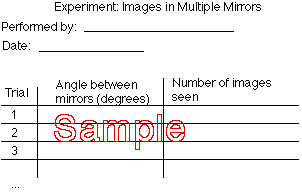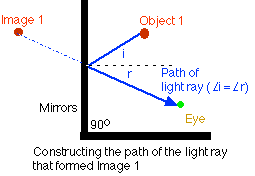Physics Experiment
Reflection in Multiple Mirrors




![[Help]](../../../NavIcons/Help.GIF)
Purpose:
To investigate the nature of multiple images in a system of
mirrors.
Discussion:
At the barber shop or hairdresser, have you ever used 2 mirrors to
look at the back of your head - one mirror in front of you and the
other behind? If so (and if you are a careful observer), what you saw
may have surprised you. This phenomenon, an extreme number of
multiple images in two parallel mirrors, is known to physicists as
the "barbershop effect".
Perhaps you have been fascinated by the colorful and symmetric
changing images in a kaleidoscope. The kaleidoscope uses multiple
images produced by a simple system of plane mirrors. These phenomena
can be explained using the Law of Reflection.
Equipment:
|
2 plane mirrors
|
mirror support
|
protractor
|
|
pin
|
paper
|
tape
|
Procedure:
Apparatus:
Tape the mirrors together so that they almost touch along one edge
and can be adjusted to form an angle between them. One way to do this
is to place the mirrors face to face and place a piece of tape around
one end of the two mirrors to form a "hinge".
Part 1 Perpendicular Mirrors:
- Draw a 90o angle near the center of a piece of
paper, and arrange the mirrors so that their reflecting surfaces
(fronts or backs?) are on the lines. The mirrors should be
arranged so that there is a precise 90o angle between
them. Place one pin in front of the mirrors (not halfway between
them is best) and look at the images of the pin in the mirrors.
Look carefully - there are not 2 images!
- Using the ray method from your previous experiment, locate all
of the images of the pin. Put this sheet of paper aside.
Part 2 Mirrors at other angles:
- On a clean sheet of paper, draw a line to represent one mirror
surface. Place your mirrors on the sheet so that one mirror lies
along this line. Mark the position of the other mirror and the
point of intersection with the other mirror.
- What you are going to do is count the number of images you can
see for angles other than 90o. In order to do this a
physicist would record her data in a data table. A data table was
supplied for you in previous experiments, but physicists do not
find ready-made data tables in their laboratories, so now it is
time to begin constructing your own data table. A sample data
table is shown below that you may use as a pattern for your own
data table.
 Notice
that the data table contains the name of the experiment, the date
the data was taken, and the name(s) of the person(s) who took the
data. Also be sure to label each column of the data table and
indicate the units in which each number was measured. (For this
activity, angles are measured in degrees and there is no unit for
the number of images, since they are counted.)
Notice
that the data table contains the name of the experiment, the date
the data was taken, and the name(s) of the person(s) who took the
data. Also be sure to label each column of the data table and
indicate the units in which each number was measured. (For this
activity, angles are measured in degrees and there is no unit for
the number of images, since they are counted.)
- Place a pin in front of the mirrors and count the images you
see. Record this information in the data table. It may be
difficult to decide how many images you actually see for some
angles - do your best here. If you cannot decide whether there are
6 or 7 images, put both numbers in the data table. The precise
number of images will not affect your analysis.
- Adjust the mirrors to another angle, count the images, and
record the data. Continue this procedure for several angles.
Analysis:
Part 1 - Perpendicular Mirrors:
Let's see if you can explain how the 3 images are seen in the
perpendicular mirrors using the Law of Reflection. What you can do is
trace the path of a light ray from your eye back to the object on
your data sheet. Refer to the figure below
- Pick a convenient spot on the object side of the mirror to
represent the location of your eye. Label this point E for
convenience.
- If you see an image in a particular direction, light had to
arrive at your eye from that direction. Draw a line representing a
light ray between one image and point E (your eye). Note where it
strikes the mirror.

- Now, the light ray you just drew did not actually come through
the mirror from the image, it was reflected from the front of the
mirror. Draw a normal to the mirror at the point the ray strikes
the mirror and measure the angle of reflection. Construct the
angle of incidence for the ray on the other side of the normal.
Does the light ray pass through the object?
- Repeat steps c and d above (do not move point E - your eye)
for each image that you find. Be sure that you understand how each
image is formed by the mirrors and the Law of Reflection.
Part II - Mirrors at Other Angles.
- What happens to the number of images as the angle between the
mirrors decreases?
- How are these multiple images formed?
- How many images would you expect to see if the mirrors are
parallel? (Try it!)
References:
Genzer & Younger, Laboratory Investigations
in Physics, p. 157-162
Robinson, Conceptual Physics Laboratory Manual, p.
249-50, 253-254




![[Help]](../../../NavIcons/Help.GIF)
last update October 27, 2007 by JL Stanbrough